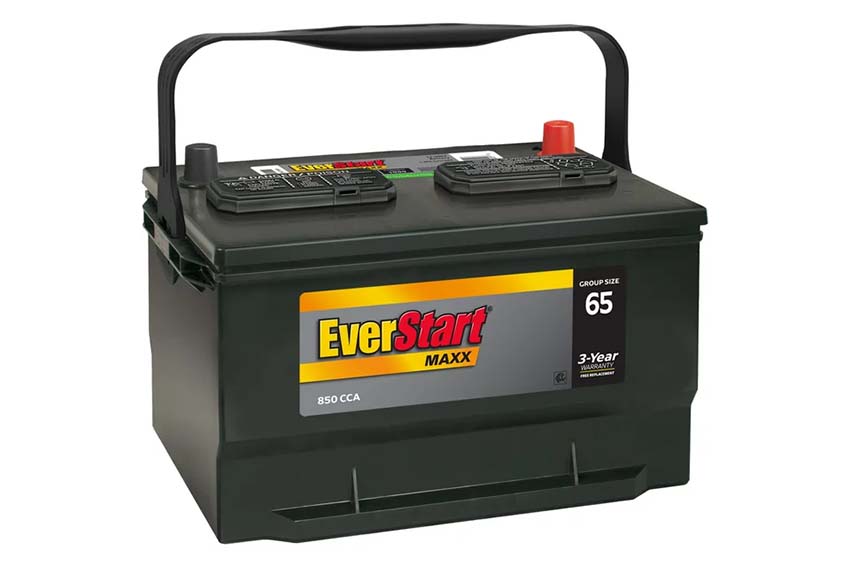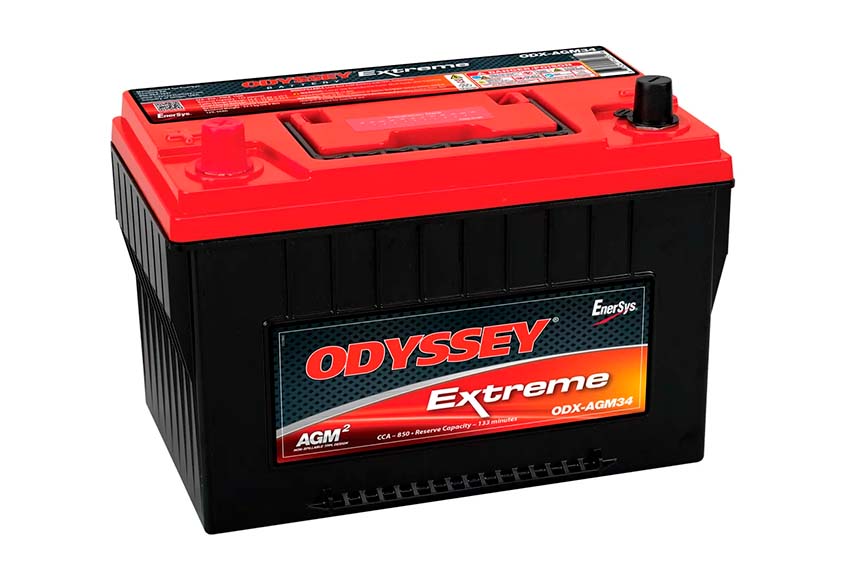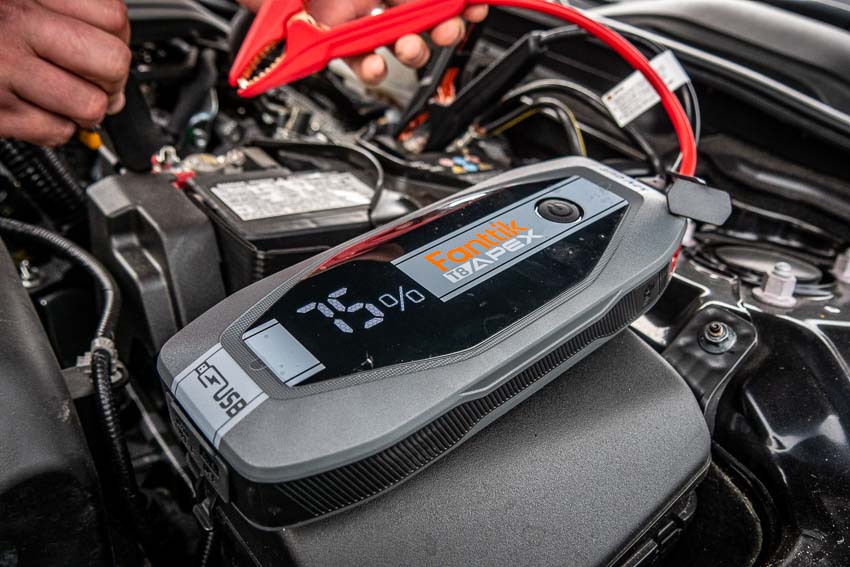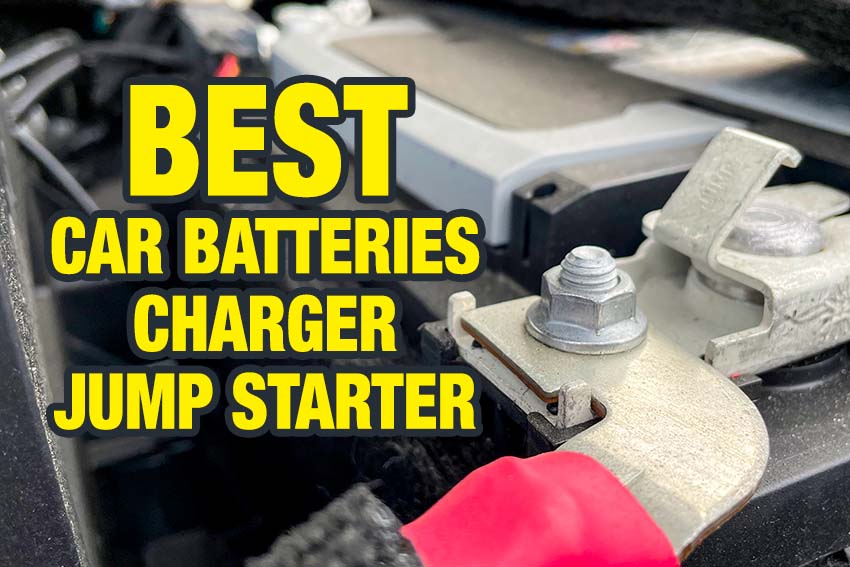When shopping for the best car battery for your vehicle, what’s your top priority? Price? Warranty? Chemistry?
Here in Central Florida, the heat is murder on car batteries. In addition to our vehicles, I also have marine batteries to manage for my flats boat. In our environment, they last around 3 years (if you’re lucky), and the cheap ones might only last a year or two. On the other hand, cold climates have their own challenges.
However, new technologies are extending typical service life… if you’re willing to pay more for them.
No matter where you live or what you drive, I’ll share my top car battery recommendations along with my favorite charger and jump starter to get you out of a pinch. If battery shopping is relatively new for you, I’ll also help you understand the terminology you need to know to make an informed decision.
Best Car Battery – Our Top Recommendations
- Best Lead Acid Car Battery: DieHard Platinum
↓ Jump to this Car Battery - Best Value Lead Acid: EverStart Maxx
↓ Jump to this Car Battery - Best AGM Car Battery: Odyssey Extreme
↓ Jump to this Car Battery - Best Value AGM: Optima Red Top
↓ Jump to this Car Battery - Best Lithium Car Battery: Dakota Lithium
↓ Jump to this Car Battery - Best Automatic Charger: Schumacher SC1281
↓ Jump to this Charger - Best Lithium Jump Starter: Fanttik T8 Apex
↓ Jump to this Jump Starter
Looking for Some Help Before You Crank Things Up? Jump to These Sections First!
- Best Car Battery Brands
- Battery Terms to Know
- Car Battery Buying Guide
- Getting the Best Life from Your Car Battery
- Why You Can Trust Pro Tool Reviews
Best Lead Acid Car Battery Overall

DieHard Platinum
- Cranking Amps: 730 – 1000
- Cold Cranking Amps: 585–800
- Reserve: 100 – 150 minutes
- Maintenance-free
- Price: $239.99
Pros
- Excellent durability and reliability
- Solid reserve capacity
- 4-year replacement warranty is longer than most (3-year on AGM batteries)
- Readily available at local Advance Auto Parts
- Free battery testing and installation
Cons
- You can step up to an AGM battery for not much more
If you’re going with standard chemistry and design, the DieHard Platinum series is the best car lead acid car battery. It uses a “Stamped Grid” design technology that essentially makes the positive and negative grid more durable and stronger than less expensive methods. Regardless of what you call it, it works. DieHard Platinum batteries enjoy an outstanding reputation among those of us who use them, including PTR crewmembers. Plus, they include an automatic 4-year replacement warranty.
Best Budget Lead Acid Car Battery for the Money

EverStart Maxx
- Cranking Amps: Not listed
- Cold Cranking Amps: 480 – 850
- Reserve: 55 – 180 minutes
- Maintenance-free
- Price: $139.99 – $159.99
Pros
- Lower cost than other brands
- More reliable than Everstart’s entry-level batteries
- Wide range of group sizes
- 3-year replacement warranty
- Readily available at your local Walmart
Cons
- Not as long-lasting as more advanced designs
- Some models have a low reserve capacity
If you’re on a smaller budget, it’s tough to beat the EverStart batteries at Walmart. Their entry-level models are pretty cheap and you can get most cars cranking for less than $100. However, I recommend stepping up to the Maxx series.
They’re over $130, but we’ve had reliable success with them, even through hot Florida summers. They come with a 3-year free replacement warranty you can claim at your local Walmart, taking some of the risk off your shoudlers. If you run into an issue, they’ll test the battery to see if it’s bad (to rule out a corroded post or connection). If it’s bad, they’ll take it off your hands, and you’ll walk out with a brand-new battery.
Best AGM Car Battery Overall

Odyssey Extreme
- Cranking Amps: 1200 – 1545
- Cold Cranking Amps: 840 – 1150
- Reserve: 135 – 220 minutes
- Maintenance-free
- Price: $396.99 – $544.99
Pros
- Outstanding power and reliability
- High cranking amps
- Excellent reserve capacity
- Better operational temp range than most batteries (-40° – 176° F)
- Longer service life than standard lead-acid
- 4-year replacement
- Readily available at several retailers
Cons
- Expensive
When it comes to the best overall AGM car battery, it’s a close race between Odyssey Extreme and Optima Yellow Top. Both go above and beyond with their designs to create a power source that’s legitimately better than other options. While Optima tends to be a little lower in price, I feel Odyssey takes the win for design technology that comes out ahead.
For the Extreme batteries, Odyssey uses 99% pure lead, not the alloys most battery plates use. That means the plates can be smaller, so you get more plates and more surface area for those chemical reactions compared to spiral-wound designs. This results in twice the power and three times the expected life compared to standard lead acid batteries.
Best AGM Car Battery for the Money

Optima RedTop
- Cranking Amps: Not listed
- Cold Cranking Amps: 720 – 800
- Reserve: 90 – 100 minutes
- Maintenance-free
- $249.99 – $299.99
Pros
- Significantly greater protection against vibration damage
- Longer life than standard lead-acid batteries
- Excellent value among AGM designs
- 3-year replacement warranty
- Readily available instore and online
Cons
- Not as high a CCA rating as other options
- Need to step up to the more expensive YellowTop for vehicles with a large electronics load or auto shut-off at stops
- More expensive than standard lead acid
I first learned about Optima batteries when they moved heavily into the fishing industry with the BlueTop line. Overnight, it seemed like professionals were swapping out their standard sealed lead acid starting and deep cycle batteries for Optima. Though they have an unusual physical design compared to traditional batteries, they have been field-proven and trusted long enough to have earned a rock-solid reputation for performance, quality, and reliability. Specifically, the spiral cell design increases vibration damage resistance up to 15 times and offers a service life up to 3 times longer than standard batteries.
With the RedTop and YellowTop models covering your car and truck needs, the RedTop earns our pick as the best AGM car battery for the money. While not the cheapest AGM you can buy, it’s more reliable. That means a lot when shopping for the best value.
Best Lithium Car Battery

Dakota Lithium LTO Automotive Cranking
- Cranking Amps: Not listed
- Cold Cranking Amps: 1100
- Reserve: 50 minutes
- Maintenance-free
- Price: $699
Pros
- High CCA
- Long service life (up to 10,000 cycles)
- Built-in jump starting reserve
- Better operational temp range than other Lithium batteries (-40° – 140° F)
- Cranking power doesn’t drop as the battery discharges
- Lightweight
- Fast charging
- 11-year warranty
Cons
- Limited group size compatibility
- Low reserve capacity
- Requires a lithium-specific charger
- Expemsive
After holding out for several years over safety concerns, I’m finally convinced that design has advanced far enough to recommend a lithium option. The best lithium car battery is Dakota’s LTO Automotive Cranking Battery.
This lightweight battery comes with a high CCA rating and a wider operating temperature range than most lithium batteries. One of the coolest features is a built-in jump starting reserve. It won’t tap into the final 25% of it capacity until you hit the jump start button when you get in a pinch. Leaving the interior light on will no longer keep you from starting your car on Monday morning.
Using LTO (Lithium Titanium Oxide), this battery is rated for up to 10,000 charge cycles and has a crazy-long 11-year warranty. Compared to the 500 cycles of a typical sealed lead acid battery, that’s 20X the service life!
The main downsides are that this model doesn’t have a wide range of compatible group sizes yet, and its low reserve capacity might be a limiting factor for some people. You’ll also need to have a lithium-specfic charger for it.
Best Car Battery Charger

Schumacher SC1281 Battery Charger
- Cranking amps: 100A
- Boost: 30A
- Voltage: 6/12 VDC
- Fully-automatic
- Price: $89.99
Pros
- Slow and fast charging
- Smart, multi-stage charging
- Starting capability
- Boost, test, and repair functions
- AGM-friendly
Cons
- Cannot charge lithium
- Not as compact as some options
- On the expensive side
We’ve recommended the NOCO Genius 2 for cars in the past. It’s an understandable pick with its low price, ability to charge lead acid, AGM, and lithium, and auto-repair function. However, that 2-amp charging rate can drive you nuts when you’re in a hurry.
Instead, take a look at the SC1281 from Schumacher as the best car battery charger. Capable of 2, 6, or 12A charging, it gets you back in the game more quickly with a multi-stage smart charge that helps extend your battery’s life. Plus, it has a 30-amp boost to bring otherwise dead batteries back to life, a 100-amp jump starter, battery tester, and auto-repair.
It’s not as compact or inexpensive as some models and doesn’t charge lithium batteries. However, the added benefits more than overcome the trade-offs for the majority of people.
Best Car Battery Jump Starter

Fanttik T8 Apex
- Cranking amps: 100A
- Boost: 30A
- Voltage: 6/12 VDC
- Fully-automatic
- Price: $199.99
Pros
- Takes up less space than most jumper cables or lead-acid jump starters
- Can jump up to 8.5L gas or 6.0L diesel engines
- Doubles as a power supply for USB-A and USB-C charging
- No need for a second vehicle to jump from
Cons
- You can find more compact models
- Expensive compared to some options
Lithium delivers power more efficiently than lead acid. This makes for smaller car batteries and also jump starters. In fact, the storage space a lithium jump starter takes up is often less than a set of jumper cables. In my opinion, the Fanntik T8 Apex is the best car battery jump starter.
While not quite as compact as the NOCO Boost Plus GB40 I also recommend, it has higher power delivery—enough to start an 8.5L gas engine or 6L diesel. This 2000-amp pack has a 20,000mAh capacity that can provide up to 50 jump starts between charges. It even has bonus USB-A and USB-C ports on board. In a pinch, use it to charge your phone or tablet.
Pro Tip: Lithium jump starters are not meant to jump a completely dead battery. Instead, they assist in helping a weak battery start a vehicle.
Best Car Battery Brands
When it comes to the best car battery brands, there are a lot of opinions, even among our crew. There are a handful of reliable choices, but there’s a kicker. If you’re saving money by purchasing a lead acid battery, buy the highest level you can afford. The gold/platinum level batteries last longer, and the extra money you spend on the front end will almost always pay for itself. A $120 battery that lasts 3 years is better in the long run than buying two $80 batteries that only last a year and a half each.
Here are the brands I’m willing to spend my hard-earned money on:
- Optima: Rock solid dependability and life
- Odyssey: Dependable battery with an Extreme line designed with a service life of up to 10 years
- Dakota Lithium: Expensive, but easily the number one choice for lithium batteries
- DieHard: Rugged, reliable option for lead acid and AGM batteries that tends to be a step up in quality from value brands
Car Battery Terms to Know
What is a Battery Group Size?
A car battery group size refers to the physical dimensions and terminal placement of the battery. Established by the Battery Council International (BCI), group sizes are standardized codes that help you identify the right battery for your vehicle.
The group size is crucial for several reasons:
- Fit: The battery must fit snugly within the battery in your vehicle. An incorrect size might not fit. Too big, and you’re bumping up against things you shouldn’t. Too small, and it has room to slide or shift. Either way, not fitting correctly can damage your vehicle and/or battery.
- Terminal Position: The position of the positive and negative terminals aren’t necessarily the same from one group size to another. Using the wrong group size could leave you with reversed terminal positions. At best, you have to stretch your cables, which can lead to shorts. At worst, they won’t reach, and you can’t make the connection.
- Capacity and Power: While group size primarily concerns physical dimensions, vehicles are often designed for specific sizes because of the power and capacity they offer. Using a battery with inadequate power can affect your vehicle’s performance. We’ll talk more about that in a minute.
What are Cranking Amps (CA) and Cold Cranking Amps (CCA)?
You’ll find a CA (Cranking Amps) and CCA (Cold Cranking Amps) designation on every car battery you buy. This specifications tells you the battery’s ability to start an engine in normal (CA) and cold (CCA) conditions. Specifically, CCA measures the number of amps a 12-volt battery can deliver for 30 seconds at 0°F (-17.8°C) without dropping below 7.2 volts.
Here’s why knowing the CCA is so important:
- Cold Weather Performance: Engines require more power to start in cold temperatures because of higher engine oil viscosity and lower chemical reactions within the battery. A higher CCA rating means the battery can provide more starting power, in all environmental conditions.
- Engine Size and Type: Larger engines or diesel engines typically require more starting power. Hence, they usually need batteries with higher CCA ratings.
- Reliability: A battery with an appropriate CCA rating for the vehicle ensures that the car starts reliably, particularly during colder months.
- Comparison: CCA provides a standard measure, allowing you to easily compare the starting performance of different batteries.
Under mild or warm conditions, the battery has higher cranking amps available, designated by the CA rating. That’s one reason your car seems easier to start in the spring and summer than it does in the dead of winter.
What is Reserve Capacity (RC)?
Reserve Capacity (RC) is a measure of a car battery’s endurance. It tells you the number of minutes a fully charged battery can continuously provide a current of 25 amps at 80°F (27°C) before its voltage drops below 10.5 volts.
Importance of Reserve Capacity
- Emergency Situations: If your vehicle’s alternator fails, the battery’s reserve capacity tells you how long the car can run on battery power alone. A battery with a higher RC can give you longer to reach your destination or a service station if you have alternator trouble.
- Accessory Power: Modern vehicles come equipped with numerous accessories like GPS, infotainment systems, and more. A higher RC allows you to run those accessories without the engine on for extended periods with a lower risk of draining the battery too far down to start the vehicle.
- Reliability: A battery with a higher RC provides a buffer during periods of high electrical demand or when the alternator isn’t functioning at its best.
- Comparison: Just like CCA, RC offers a standardized measure, enabling you to compare the endurance of different batteries.
How to Determine Reserve Capacity
Some batteries list the reserve capacity on the label. Others may list it on website product pages in the specifications. Many of the lower-priced batteries, including ones we use, don’t list it in either location. You can calculate an estimate, though. You just need the battery’s amp hours (Ah).
Take the amp hours, divide by 25, and then multiply that value by 60 to get the number of reserve minutes. Here’s an example using Optima’s Yellow Top D34:
- 55Ah / 25 Amps = 2.2 hours of reserve
- 2.2 hours x 60 minutes in an hour = 132 minutes of reserve capacity
Like I said, it’s an estimate. Optima’s actual RC is 120 minutes on this model, but you get in the ballpark with this calculation.
Best Car Battery Buying Guide
How Much Should a Car Battery Cost?
It’s possible to get a car battery under $100. However, you get what you pay for, and those batteries often only last a year or so. Most quality batteries start a little over $100 for standard lead acid and can be well over $1,000 if you’re buying lithium.
What Car Battery Group Size Do I Need?
There are a few ways to determine what battery group size you need. The easiest is to look at the label on the battery that’s already in your vehicle. If you match the group size and CCA rating, you should be just fine.
Another option is to check online. If you go to the retailer’s website you prefer to shop at, you can enter your vehicle’s information and let the system look up which batteries they carry that will work for you.
You can also just go to the store. Most dedicated auto parts stores can look it up on their system with some information from you and immediately know what they have in stock. Other stores, like Walmart, have a book or electronic device in the battery section where you can look up your vehicle and see the compatible batteries.
Lead Acid vs AGM vs Lithium Car Batteries
The three primary battery chemistries are lead-acid, AGM (Absorbent Glass Mat), and lithium. Each has its advantages and disadvantages. Here are the primary considerations:
Lead-Acid Batteries
Lead-acid batteries have been around the longest and are the most affordable. They have a decent lifespan with proper maintenance, and some premium batteries can last 5 years or longer. They’re also capable of delivering high current, making them well-suited for starting vehicles.
On the downside, they’re heavier compared to other types, require regular maintenance (like topping off with distilled water), and can be prone to sulfation if you don’t keep them properly charged.
AGM (Absorbent Glass Mat) Batteries
AGM batteries are a type of lead-acid battery that uses an absorbent glass mat (fiberglass) rather than the less-constrained liquid of a standard battery. These designs are sealed, making them effectively maintenance-free. They offer a longer lifespan, faster charging, and better cold-temperature performance than traditional lead-acid batteries. They’re also more resistant to vibration and can be mounted in a wide range of positions.
The main downsides are that they’re more expensive than traditional lead-acid batteries and can be damaged if overcharged. It’s helpful to have a battery charger with an AGM-specific setting (though AGM/Gel combo settings can keep AGM batteries from reaching a full charge).
Even though they’re more expensive, AGM batteries offer the best balance of performance, life, and price compared to standard and lithium car batteries.
Lithium Batteries
Lithium car batteries are lightweight, have a high energy density, and can deliver a consistent voltage throughout their discharge cycle. They have a longer lifespan, can be charged quickly, and are maintenance-free. If you can afford lithium, it’s the best overall car battery chemistry currently available.
However, they’re the most expensive among the three main types, and you need to use a lithium-specific charger for them. There are also concerns about safety, as they can catch fire if damaged or improperly charged.
Do yourself a favor and don’t skimp by buying cheap lithium batteries or chargers—thermal runaway is no joke. You can’t put out a lithium fire with water the same way you can others. Worse, many local fire departments don’t have the equipment to put out a lithium fire. If a lithium fire starts in your garage, the damage is likely to be severe.
That said, quality lithium batteries don’t fail very often.
Getting the Best Life from Your Car Battery
One of the nice things about AGM and lithium car batteries is that they’re essentially maintenance-free. As long as you make sure you use the right charger settings if you need to connect one, they’re about as worry-free as you can hope for.
Standard lead-acid is a different story, though. Here are some tips to get the most life from your car battery:
- Clean the Terminals: Remove any corrosion from the terminals using a mixture of baking soda and water, followed by a thorough wipe-down. Yes, Coke or other acidic sodas really do work, too. Just try to wash all of it off with clean water when you’re done.
- Tighten Connections: Make sure the battery terminals are secure on the terminal posts to prevent any movement or disconnection.
- Maintain Electrolyte Level: For non-sealed batteries, ensure the electrolyte level is between the minimum and maximum marks. Top up with distilled water if needed. Don’t use tap water.
- Regular Charging: Avoid letting the battery discharge completely. If you’re not driving the vehicle frequently, a trickle charge is a great way to maintain the battery.
- Avoid Deep Discharges: Deep discharging can reduce the battery’s lifespan significantly. Start the car regularly or use a trickle charger to prevent this. There are deep cycle batteries available specifically designed for frequent deep discharges.
- Secure the Battery: Ensure the battery is firmly secured in its tray to prevent vibrations and potential damage. This is one of the leading causes of battery damage.
- Compensate for Short Rides: Short rides can prevent your car’s alternator from fully chargning the battery. Take longer rides occasionally, or use a battery charger to keep the battery topped off.
- Check Your Alternator: Ensure the alternator works correctly—a faulty alternator can overcharge or undercharge the battery.
- Avoid Extreme Temperatures: If possible, park the car in a garage during extreme weather conditions. Both high and low temperatures can affect battery performance and life.
Why You Can Trust Pro Tool Reviews
Ever check out a “review” site and you can’t tell if they use tools or if they’re just “recommending” the Amazon top sellers? That’s not us. We won’t recommend anything unless we’d actually use it ourselves and we don’t really care who the primary retailer is. It’s all about giving you a legitimate recommendation and our honest opinion of each product.
Since 2008, we’ve been bringing in and reviewing hundreds of individual tools and products each year. Our team will then put our hands on hundreds more tools and products at media events and trade shows throughout the year. We also consult with manufacturers and engineers who pioneer the technology and design of tools and accessories to better understand where these products fit and how they work.
This year, we’ll provide more than 500 pieces of new content absolutely free for our readers—including objective evaluations of individual tools and products. The end result is information you can trust because of the editorial, scientific, and real-world professional experience we collectively utilize each and every time we pick up and test a tool.



